
Fukuoka Prefecture is a prefecture of Japan located on the island of Kyūshū. Fukuoka Prefecture has a population of 5,109,323 and has a geographic area of 4,986 km2. Fukuoka Prefecture borders Saga Prefecture to the southwest, Kumamoto Prefecture to the south, and Ōita Prefecture to the southeast.

Dazaifu is a city located in Fukuoka Prefecture, Japan. As of 31 March 2024, the city had an estimated population of 71,505 in 33204 households, and a population density of 260 persons per km². The total area of the city is 29.60 km2 (11.43 sq mi).

Settsu Province was a province of Japan, which today comprises the southeastern part of Hyōgo Prefecture and the northern part of Osaka Prefecture. It was also referred to as Tsu Province or Sesshū (摂州).
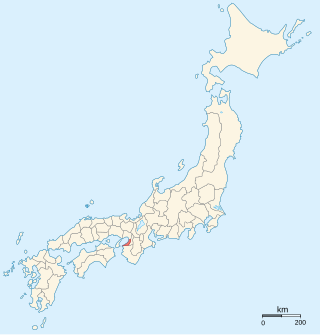
Izumi Province was a province of Japan in the area of southern Osaka Prefecture. It bordered on Kii to the south, Yamato and Kawachi to the east, and Settsu to the north. Its abbreviated form name was Senshū (泉州). In terms of the Gokishichidō system, Izumi was one of the provinces of the Kinai circuit. Under the Engishiki classification system, Izumi was ranked as one of the "inferior countries" (下国) in terms of importance. The provincial capital was located in the Fuchi neighborhood of what is now the city of Izumi. The ichinomiya of the province is the Ōtori taisha also located in Sakai.
Akizuki Tanezane was a samurai warrior and daimyo in 16th century Japan. He was a member of the Akizuki clan from Chikuzen Province, son of Akizuki Kiyotane; his father was defeated by the Ōtomo clan. in 1564.

Ōsumi Province was a province of Japan in the area of southeastern Kyūshū, corresponding to the eastern half of modern Kagoshima Prefecture, and including the Ōsumi Islands. Ōsumi bordered on Hyūga to the northeast, and Satsuma Province to the northwest. Its abbreviated form was Gūshū (隅州). In terms of the Gokishichidō system, Ōsumi was one of the provinces of the Saikaidō circuit. Under the Engishiki classification system, Ōsumi was ranked as one of the "middle countries" (中国) in terms of importance, and one of the "far countries" (遠国) in terms of distance from the capital.

Buzen Province was a province of Japan in the area of northeastern Kyūshū, corresponding to part of southeastern Fukuoka Prefecture and northwestern Ōita Prefecture. Buzen bordered on Bungo to the south, and Chikuzen to the north and west. Its abbreviated form name was Hōshū (豊州), although it was also called Nihō (二豊). In terms of the Gokishichidō system, Buzen was one of the provinces of the Saikaidō circuit. Under the Engishiki classification system, Buzen was ranked as one of the "superior countries" (上国) in terms of importance, and one of the "far countries" (遠国) in terms of distance from the capital.

Bungo Province was a province of Japan in the area of eastern Kyūshū, corresponding to most of modern Ōita Prefecture, except what is now the cities of Nakatsu and Usa. Bungo bordered on Hyūga to the south, Higo and Chikugo to the west, and Chikuzen and Buzen to the north. Its abbreviated form was Hōshū (豊州), although it was also called Nihō (二豊). In terms of the Gokishichidō system, Bungo was one of the provinces of the Saikaidō circuit. Under the Engishiki classification system, Bungo was ranked as one of the "superior countries" (上国) in terms of importance, and one of the "far countries" (遠国) in terms of distance from the capital.

Chikuzen Province was a province of Japan in the area of northern Kyūshū, corresponding to part of north and western Fukuoka Prefecture. Chikuzen bordered on Hizen to the east, and Buzen east, and Bungo to the southeast. Its abbreviated form name was Chikushū (筑州), although it was also called Chikuyo (筑陽). In terms of the Gokishichidō system, Chikuzen was one of the provinces of the Saikaidō circuit. Under the Engishiki classification system, Chikuzen was ranked as one of the "superior countries" (上国) in terms of importance, and one of the "far countries" (遠国) in terms of distance from the capital.

Higo Province was an old province of Japan in the area that is today Kumamoto Prefecture on the island of Kyūshū. It was sometimes called Hishū (肥州), with Hizen Province. Higo bordered on Chikugo, Bungo, Hyūga, Ōsumi, and Satsuma Provinces.

Hyūga Province was a province of Japan in the area of southeastern Kyūshū, corresponding to modern Miyazaki Prefecture Hyūga bordered on Ōsumi to the south, Higo to the west, and Bungo to the north. Its abbreviated form name was Kōshū (向州), although it was also called Nissshū (日州). In terms of the Gokishichidō system, Hyūga was one of the provinces of the Saikaidō circuit. Under the Engishiki classification system, Hyūga was ranked as one of the "middle countries" (中国) in terms of importance, and one of the "far countries" (遠国) in terms of distance from the capital.
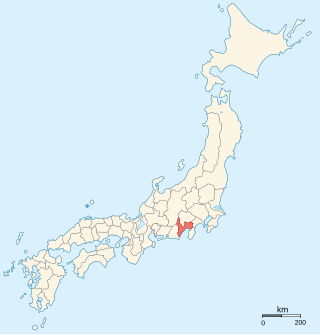
Suruga Province was an old province in the area that is today the central part of Shizuoka Prefecture. Suruga bordered on Izu, Kai, Sagami, Shinano, and Tōtōmi provinces; and was bordered by the Pacific Ocean through Suruga Bay to the south. Its abbreviated form name was Sunshū (駿州).

Nabeshima Naoshige was a warlord of the Sengoku and early Edo periods and progenitor of the Nabeshima lords of the Saga Domain. Naoshige was the second son of Nabeshima Kiyofusa. His mother was the daughter of Ryūzōji Iesumi. He was a vassal of the Ryūzōji clan during the Sengoku period of the 16th century.

Kurume is a city in Fukuoka Prefecture, Japan. As of 1 February 2024, the city had an estimated population of 295,367 in 137,140 households, and a population density of 1309 persons per km². The total area of the city is 229.96 km2 (88.79 sq mi).

Kurume Domain was a Japanese domain of the Edo period. It was associated with Chikugo Province in modern-day Fukuoka Prefecture on the island of Kyushu.
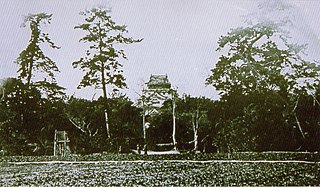
Yanagawa Domain was a feudal domain under the Tokugawa shogunate of Edo period Japan, in what is now eastern Fukuoka Prefecture. It was centered around Yanagawa Castle in what is now the city of Yanagawa, Fukuoka and was ruled by the tozama daimyō Tachibana clan for much of its history.

Mizuta Tenmangū (水田天満宮) is a Shinto shrine in Chikugo, Fukuoka Prefecture, Japan.
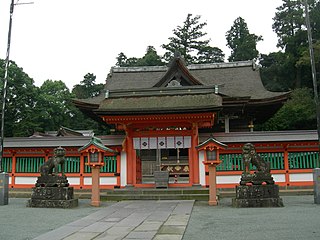
Kōra Taisha is a Shinto shrine located on Mount Kōra of the city of Kurume, Fukuoka Prefecture, Japan. It is the ichinomiya of former Chikugo Province as well as its sōja shrine. The shrine's main festival is held annually on 9 October. It was also known as the Kōra Tamatare no mikoto Jinja (高良玉垂命神社) or the Kōra Tamatare no miya (高良玉垂宮)
Tsukushi Province was an ancient province of Japan, in the area of Chikuzen and Chikugo provinces. This province was located within Fukuoka Prefecture. It was sometimes called Chikushū (筑州).
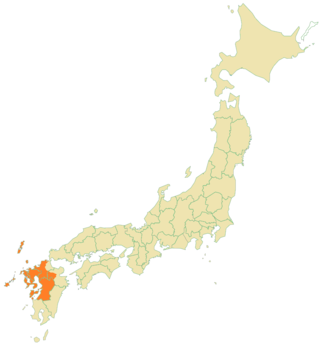
The Hichiku dialectHichiku hōgen (肥筑方言) is a group of the Japanese dialects spoken in western Kyushu. The name Hichiku (肥筑) is constructed by extracting a representative kanji from Hizen (肥前), Higo (肥後), Chikuzen (筑前) and Chikugo (筑後), the names of old provinces.
























